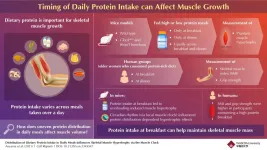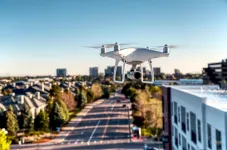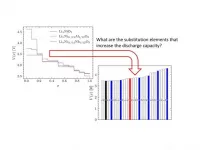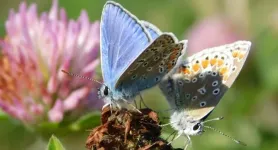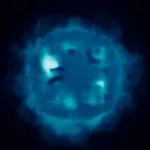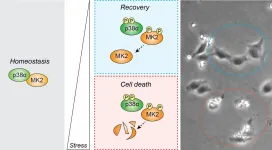(Press-News.org) A coronavirus related to the virus that causes Covid-19 in humans has been found in UK horseshoe bats - according to new collaborative research from the University of East Anglia, ZSL (Zoological Society of London), and Public Health England (PHE).
However, there is no evidence that this novel virus has been transmitted to humans, or that it could in future, unless it mutates.
UEA researchers collected faecal samples from more than 50 lesser horseshoe bats in Somerset, Gloucestershire and Wales and sent them for viral analysis at Public Health England.
Genome sequencing found a novel coronavirus in one of the bat samples, which the team have named 'RhGB01'.
It is the first time that a sarbecovirus (SARS-related coronavirus) has been found in a lesser horseshoe bat and the first to be discovered in the UK.
The research team say that these bats will almost certainly have harboured the virus for a very long time. And it has been found now, because this is the first time that they have been tested.
Importantly, this novel virus is unlikely to pose a direct risk to humans, unless it mutates.
A mutation could happen if a human infected with Covid-19 passes it to an infected bat, so
anyone coming into contact with bats or their droppings, for example those engaged in caving or bat protection, should wear appropriate PPE.
Prof Diana Bell, an expert in emerging zoonotic diseases from UEA's School of Biological Sciences, said: "Horseshoe bats are found across Europe, Africa, Asia and Australia and the bats we tested lie at the western extreme of their range.
"Similar viruses have been found in other horseshoe bat species in China, South East Asia and Eastern Europe.
"Our research extends both the geographic and species ranges of these types of viruses and suggests their more widespread presence across more than 90 species of horseshoe bats.
"These bats will almost certainly have harboured this virus for a very long time - probably many thousands of years. We didn't know about it before because this is the first time that such tests have been carried out in UK bats.
"We already know that there are different coronaviruses in many other mammal species too," she said. "This is a case of 'seek and you will find'.
"Research into the origins of SARS-CoV-2, the virus that causes Covid-19 in humans, has focussed on horseshoe bats - but there are some 1,400 other bat species and they comprise 20 per cent of known mammals.
"Our findings highlight the need for robust genotype testing for these types of viruses in bat populations around the world. And it raises an important question about what other animals carry these types of viruses."
Prof Andrew Cunningham, from the Zoological Society of London, said: "Our findings highlight that the natural distribution of sarbecoviruses and opportunities for recombination through intermediate host co-infection have been underestimated.
"This UK virus is not a threat to humans because the receptor binding domain (RBD) - the part of the virus that attaches to host cells to infect them - is not compatible with being able to infect human cells.
"But the problem is that any bat harbouring a SARS-like coronavirus can act as a melting pot for virus mutation. So if a bat with the RhGB01 infection we found were to become infected with SARS-CoV-2, there is a risk that these viruses would hybridise and a new virus emerge with the RBD of SARS-CoV-2, and so be able to infect people.
"Preventing transmission of SARS-CoV-2 from humans to bats, and hence reducing opportunities for virus mutation, is critical with the current global mass vaccination campaign against this virus."
Prof Bell added: "The main risks would be for example a bat rehabilitator looking after a rescued animal and infecting it with SARS-CoV2 - which would provide an opportunity for genetic recombination if it is already carrying another sarbecovirus.
"Anyone coming into contact with bats or their droppings, such as bat rescuers or cavers, should wear appropriate PPE - in order to reduce the risk of a mutation occurring.
"We need to apply stringent regulations globally for anyone handling bats and other wild animals," she added.
The new virus falls within the subgroup of coronaviruses called sarbecoviruses which contains both SARS-CoV-2 (responsible for the current pandemic) and SARS-CoV (responsible for the initial 2003 SARS outbreak in humans).
Further analysis compared the virus with those found in other horseshoe bat species in China, South East Asia and Europe and showed that its closest relative was discovered in a Blasius's bat from Bulgaria in 2008.
The UK discovery was made by undergraduate ecology student Ivana Murphy, from UEA's School of Biological Sciences, who collected bat droppings as part of her final year research dissertation. Jack Crook conducted the genetic analyses in partnership with other researchers at PHE.
A total of 53 bats were captured, and their faeces collected in sterile bags. The research was conducted under strict Health and Safety protocols. Full PPE was worn and Ivana was regularly tested for Covid-19 to avoid any chance of cross contamination. The bats were released immediately after their droppings had been collected.
Ivana said: "More than anything, I'm worried that people may suddenly start fearing and persecuting bats, which is the last thing I would want and would be unnecessary. As like all wildlife, if left alone they do not pose any threat."
INFORMATION:
'Metagenomic identification of a new sarbecovirus from horseshoe bats in Europe' is published in the journal Scientific Reports on July 19, 2021.
UK policymakers preparing trade deals post-Brexit can learn important lessons from New Zealand's 'unique drug agency' the Pharmaceutical Management Agency (PHARMAC), if prices for therapies and access to key drugs are to be protected, say researchers behind a new study.
Over two decades, New Zealand has managed to reduce spending on drugs significantly and consistently despite maintaining access for its population to key treatments. As such, it is an outlier among the world's richest nations: no other OECD country has managed to achieve this.
The investigation from researchers at the universities of Bath and Durham suggest New Zealand's ...
Research led by the University of Southampton into the uptake of the COVID-19 vaccine in Ghana, West Africa has concluded that vaccine hesitancy has seen a small, but significant increase over the last three months. This research is in collaboration with youth-led not-for-profit organisation PACKS Africa.
In the latest survey of 1,295 unvaccinated people, in May/June 2021, willingness to be vaccinated remained relatively high at just over 71.4 percent. However, this figure is down 11 percent on results from March 2021 when an earlier version of the same survey was conducted.
The latest findings show 28.6 percent of respondents are still either undecided or unwilling to get the jab. Among this 28.6 percent group, a little over half said ...
Proteins constitute an essential dietary component that help in the growth and repair of the body. Composed of long chains of amino acids, proteins promote the growth of skeletal muscles, the group of muscles that help us move. Humans have been aware of the benefits of proteins for long. However, recent studies have shown that having the right amount of protein at the right time of the day is essential for proper growth. This is called 'Chrononutrition,' in which when you eat is as important as what and how you eat.
The reason behind this is the body's internal biological clock, called the 'circadian rhythm.' This rhythm is followed by all cells and controls life functions like metabolism and growth. Interestingly, protein digestion and absorption have been ...
Chemical synapses transmit information within the nervous system. When a presynaptic cell is electrically excited, synaptic vesicles fuse with the presynaptic membrane causing messenger substances within the vesicles to be released into the synaptic cleft. These then bind to receptors in the postsynaptic cell where they trigger an electrical signal once again. The temporal and spatial sequence of the incoming signals determines how information is processed and transmitted in the brain. In order to sustain their function in the long term, chemical synapses need to recycle synaptic vesicles to make them available for renewed signal transmission. Professor Carsten Duch and Professor Martin Heine and their respective ...
"The project's main objective is to integrate a certain degree of automation, so that an operator can control a small fleet of up to 10 drones from a single ground station," says Luis E. Moreno, LABYRINTH's coordinator and researcher at the UC3M's Robotics Lab. "The idea is that the operator indicates the mission to be undertaken (for example, monitoring traffic in a particular area) and the system automatically converts this mission into a set of routes that each drone has to follow, automatically calculating alternative routes when necessary," he explains. In addition ...
The economic and environmental pros and cons of melting Arctic ice creating shorter shipping routes through the polar region are weighed up in ground-breaking research from UCL experts in energy and transport.
They conclude that policy makers must properly assess the environmental trade-offs and costs in addition to the commercial benefits and opportunities in Arctic shipping. The authors also want to see more incentives to drive technological developments that will accelerate the uptake of green fuels and technologies.
The Arctic is the fastest-warming region on the planet.
Shorter Arctic shipping routes, which mean less fuel used are already used by a handful of ships, when areas of the Arctic ice melt ...
Ishikawa, Japan - Powering everything from smartphones to electric cars, lithium-ion batteries (LIBs) have evolved markedly with advances in technology and revolutionized our world. The next step in the progress of technology is developing even better batteries to power electronic devices for longer durations. One promising technique for increasing battery performance involves the atomic substitution of positively charged ions or "cations" in the cathode material. However, doing so systematically for different substituent cations to determine the ideal ones experimentally is complex and expensive, leaving us with simulations as the only viable option for narrowing down the choices.
Several studies have reported an improved battery life and ...
This summer, if you see a butterfly with wings that are blue on top with orange spots underneath, you may have crossed paths with a male European Common Blue (or Polyommatus icarus), a newly introduced species in Canada.
Could it be a fluke? Probably not, according to a group of researchers from the University of Ottawa who have taken a close look at this captivating blue creature. They are in fact the first to study its ecology.
"The results of our study suggest that the Polyommatus icarus (P. icarus) could become widespread in the future since it prefers urban areas," said uOttawa PhD student Stephanie Rivest, who is the first ...
The final stage of cataclysmic explosions of dying massive stars, called supernovae, could pack an up to six times bigger punch on the surrounding interstellar gas with the help of cosmic rays, according to a new study led by researchers at the University of Oxford. The work will be presented by PhD student Francisco Rodríguez Montero today (19 July) at the virtual National Astronomy Meeting (NAM 2021).
When supernovae explode, they emit light and billions of particles into space. While the light can freely reach us, particles become trapped in spiral loops by magnetic shockwaves generated during the explosions. Crossing back and forth through shock fronts, these particles are accelerated almost to the speed of light and, on escaping the supernovae, are thought ...
Living organisms are often exposed to stress stimuli generated either by external or internal factors, and they need to respond accordingly. At a cellular level, stress usually triggers the activation of survival pathways that contribute to the recovery of cell homeostasis. However, when stress is too high, a process of cell death is initiated that eliminates the damaged cell.
Scientists led by ICREA researcher Dr. Angel Nebreda, head of the Signalling and Cell Cycle laboratory at IRB Barcelona, have identified an important role of the p38-MK2 pathway in determining cell fate in response to stress.
"Our ...
